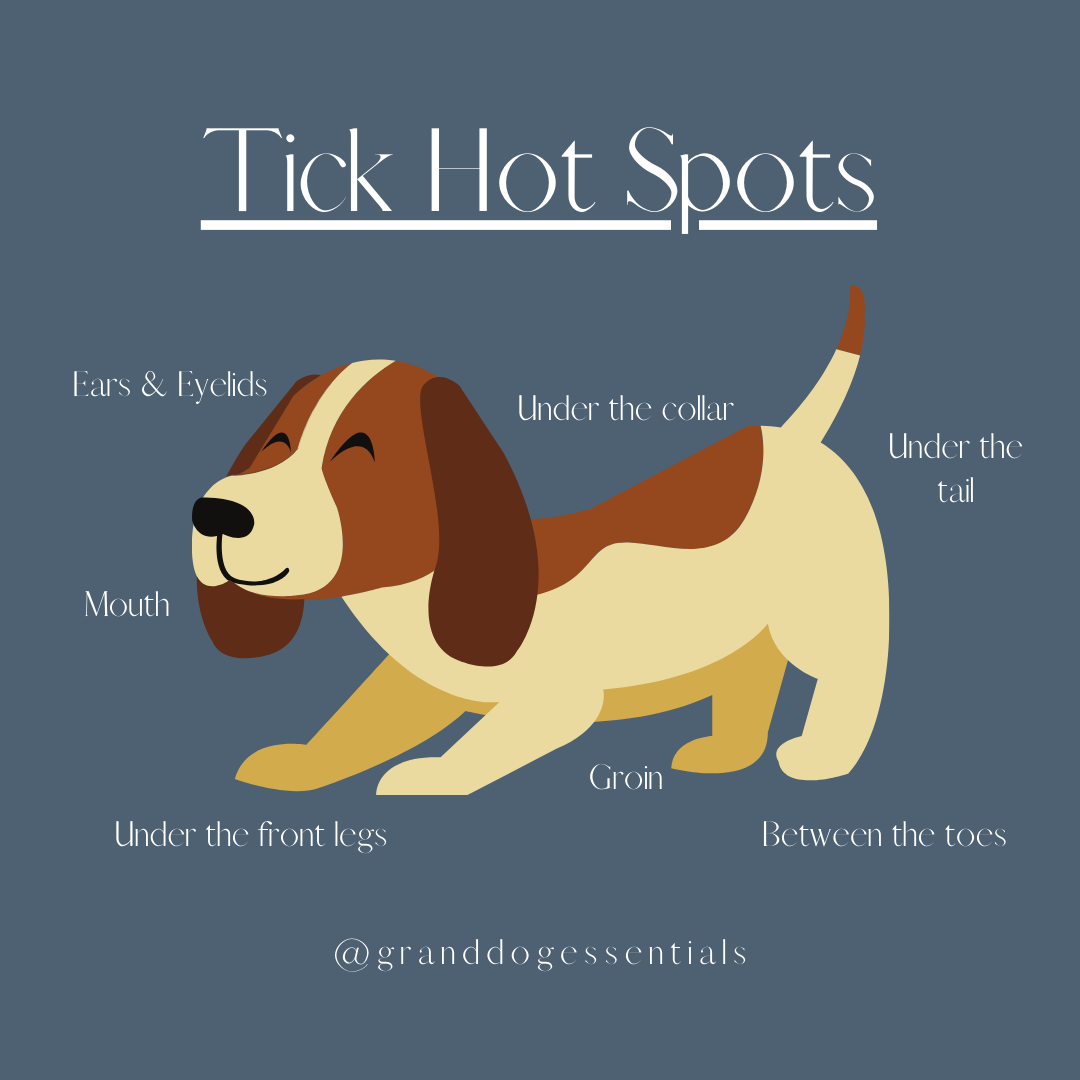How to Protect Your Dog from Ticks
June 10, 2020 – Amanda Monsma

With the arrival of warmer weather in Alberta comes increased time outside for yourself and your dogs. The warmer weather is also when ticks are most active. As dog owners, it's important to be aware of when these pests are out, how to prevent and detect them, and how to remove them if you or your dog is bitten.
WHAT ARE TICKS?
Ticks are small spider like animals that bite and attach themselves to their prey to draw blood. Ticks are most active in the warmer months - spring, summer, and fall. They thrive in grassy and wooded areas but are also known to be in urban areas as well.

(Photo provided by Central Alberta Lyme Society)
TICK PREVENTION
The following are ways for both dogs and humans to prevent tick bites:
- Stick to cleared paths when able and limit walking through areas with tall grass
- Wear proper clothing while out in high risk areas, covering up as much skin as possible. Light colour clothing helps you spot ticks quicker. Tuck shirt into pants and pants into socks.
- Use spray containing Icaridin (Picaridin). It has been proven to be more effective than DEET and doesn't have the harmful components that DEET has. Effective for up to 12 hours.
- Oil of Lemon Eucalyptus is a natural source of protection. Effective for up to 2 hours.
- If your dog gets hair cuts, keep their hair short during tick season.
- After time outside, check over yourself and your dog for any bites. Remove any ticks you find immediately.
- Supplement your dogs diet with garlic and apple cider vinegar as they both make your dogs less appealing to ticks. Add two tablespoons of ACV to their food or water per day. For the garlic, make sure to crush or chop up the garlic and let sit for 10-15 minutes before serving to allow the medicinal properties to activate. Feed 1 tsp per 30 lbs of body weight per day for garlic.
Click here for more benefits of feeding garlic to your dog(s).
Using a combination of the above preventative measures is the best way to ensure you and your dog are safe from ticks.
TICK HOT SPOTS
Make it a habit to check over your dogs every day during tick season, especially after out in high risk areas. To check your dog for ticks, gently rub your hands through their fur to check for any bumps.
Hot spots on a dog are:
- ears and eyelids
- collar area
- mouth
- under the front legs
- groin
- between toes
- under the tail

(Photo provided by Central Alberta Lyme Society)
HOW TO REMOVE TICKS
While the risk of contracting Lyme disease is low in Alberta, it is still a risk. Any contact with ticks should be taken seriously and ticks should be removed within 24 hours of contact. The Central Alberta Lyme Society provides tick removal kits that you can store in your trailer, at home, or in your car. I contacted them for a kit and within a day I had 4 kits in my possession for myself and members of my family. You can request your kit through their Facebook Page.
The instructions below on how to remove a tick for both humans and dogs comes directly from the Government of Alberta site:
- Using tweezers, gently grasp its head and mouth parts as close to your skin as possible to avoid leaving mouthparts in the skin or crushing the tick.
- Without squeezing the tick, slowly pull the tick straight up off the skin – do not jerk or twist it.
- Do not apply matches, cigarettes, dish soap or petroleum jelly to the tick. This will not encourage the tick to detach and may cause it to release infectious blood back into the wound.
- Once the tick has been removed, clean the bite area with soap and water and disinfect the area with an antiseptic. Wash hands with soap and water.
- Once removed, dispose of a live tick by putting it in rubbing alcohol, placing it in a sealed bag or container. Never crush a tick with your fingers.
- If you are concerned about your health, you can keep the tick for future testing if you develop symptoms of an infection, such as Lyme disease.
- Save the tick in a clean, empty container. Do not add any ventilation holes to the container that is being used to put the tick(s) in. You can put more than one tick in the container if they are found on the same person or in the same general area in the environment.
- Add a small piece of tissue or cotton ball, lightly moistened with water, into the container to prevent the tick(s) from drying out.
- Ticks can be stored for 10 days in the refrigerator or freezer.
- Submit the tick for testing as soon as possible.
- If you do not plan to submit the tick for testing, you can dispose of it by flushing it down the toilet.
Most vets are able to accept ticks for testing - contact your vet for the most updated information on tick testing. To locate AHS offices that accept ticks for testing for humans, click here.
The best way to prevent infection is to be diligent and always checking yourself and your dogs for ticks, especially after spending time outdoors.
I hope you found this helpful! Please help spread the word by sharing our blog post with your friends. If you have had experience with ticks and Lyme disease in Alberta, feel free to share in the comments below. The more we know, the better we can defend ourselves and our dogs.
Amanda Monsma
If you enjoyed this, you might like to read Three Reasons to Feed Summer Fruit to Your Dog.
RESOURCES
https://www.alberta.ca/lyme-disease-tick-surveillance.aspx
https://www.albertaspca.org/tick-flea-season/
https://www.albertaanimalhealthsource.ca/content/ticks-alberta-what-you-need-know
https://www.dogsnaturallymagazine.com/natural-solutions-tick-season/
https://www.dogsnaturallymagazine.com/top-natural-mosquito-repellents-dogs/

2 comments
Hi Kathy! Thanks for sharing your comment! We have done research on garlic prior to posting, and there is some misconception around if it’s safe for dogs. From our research, we have determined that it is safe for most dogs when given in appropriate amounts and done properly. If interested, we dive more into it on this Instagram post: https://www.instagram.com/p/CXi23oILHzF/
This is a highly informative post packed with many options for tick prevention. Unfortunately garlic, like onions, is in the allium family and is toxic to dogs.
Perhaps someone could add an addendum regarding this issue?